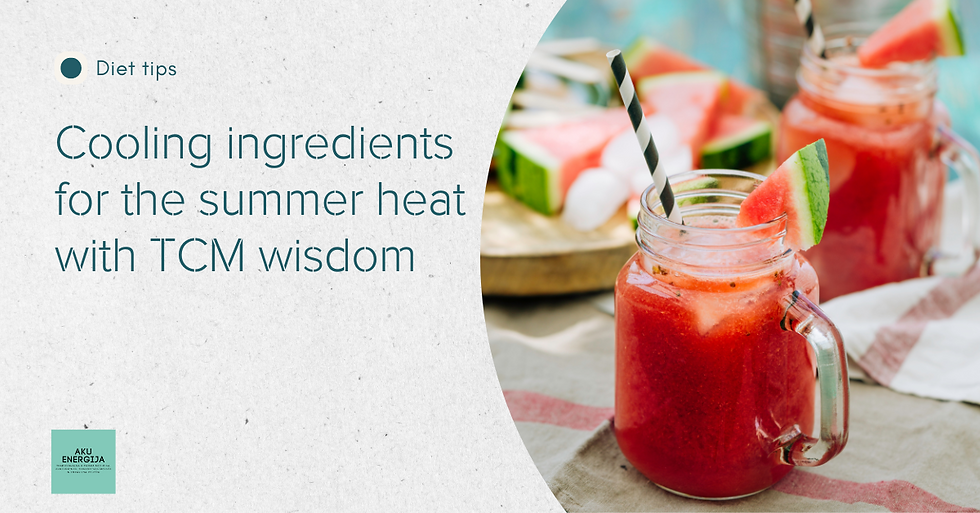Cooling ingredients for the summer heat with TCM wisdom
- Aku Energija
- Jul 19, 2024
- 4 min read
Da Shu 大暑 or Major Heat is the twelfth solar term of the 24 traditional Chinese solar terms, and also the last solar term of the summer season. It falls between July 22 and 24 in the Gregorian calendar. Major Heat period is the time with the highest temperature of the year. [Read more: TCM Cooling Tips for Summer]

In terms of health preservation during Great heat, the focus is on the concept of "qing 清" (clearness), which means emphasizing a "clean" diet and "clearing heat" within the body, while also engaging in "clear nourishment." In the TCM Yin Yang theory, Qing is a Yang property opposing “zhuo 濁” (turbidity). In practice, clear nourishment primarily involves eliminating dampness by consuming light and easily digestible foods to avoid burdening the gastrointestinal system. Examples of turbid and damp food are
Dense and damp food like unfermented dairy products
Very sugary foods like cakes, ice cream and even some fruits like banana and mango
Indirect dampness caused by slow metabolism like cold and raw food
[Read more: TCM Dietary Advice] [Read more: Cook your food - digestive system explained in Traditional Chinese medicine]
During the period of Major Heat, it is advisable not to expose the body excessively to high temperatures, as it may impair temperature regulation functions. "Cleanliness" is extremely important in summer, as high temperatures can easily lead to food spoilage, resulting in diarrhea and gastrointestinal disorders.
Here some a few cooling recipes suggested by our TCM herbalist.
1. Mung Bean Soup
Ingredients
1/2 cup mung beans
1/4 cup rice
1000 ml water
1/2 tablespoon raw sugar
Instructions
Rinse the mung beans and rice in clean water.
In a large pot, add 1/2 cup of mung beans and 1/4 cup rice with 1000ml water (you can put more water if you prefer it more watery)
Boil all the content and then continue cooking for around 30-45 minutes
Add 1/2 tablespoon raw sugar when then soup is done
Cool down and eat, save the leftover in the refrigerator and gently reheat it when consuming.
2. Watermelon Peel Water
Clean the surface of the watermelon peel (the green and white part that we usually throw away), chop into small pieces and boil for 15 minutes then drink it like cucumber water.
3. Sautéed Watermelon Rind
Ingredients
2 tbsp. olive oil
1 medium onion
4 cloves garlic
2 cups watermelon rinds (dark green edge removed, chopped into small cubes)
1 tbsp. soy sauce
1 large tomato
½ tsp. oregano
Fresh basil, torn or chopped
Salt and pepper, to taste
Instructions
Start by prepping your vegetables. Chop the onion into thick slices, and cut those slices in half. Mince the garlic. Make sure all the red watermelon flesh is removed from the rind. You can leave the green skin on the watermelon if you like- it will soften a lot as you cook, but still be a little tough. Chop the tomato in small pieces.
Heat your olive oil in a large skillet with a lid. Add the onion and garlic, and cook for a minute or two. Add the watermelon rinds and soy sauce, and stir so the rinds are coated. Add the tomato and half a cup of water. Cover, and let simmer for 10 minutes.
After 10 minutes, remove the lid. Cook for a few minutes, stirring, to allow excess water to evaporate. Add the oregano, salt and pepper to taste. Turn off the heat, add fresh basil, and serve. Excellent over pasta, bread, or as is.
4. Honeysuckle Tea
Honeysuckle is a “weed” that grows wild. It is considered an invasive species becuase it could take over other plants’ space and sun. But its flower is a Chinese herbal medicine. Gather the flower bulb (the one before blossom) in early summer, and dry it in cool place. Use a few of them, or maybe together with the elderflower in 85 degrees hot water for 30 seconds then drink the tea.
5. Fermented Cucumbers (Brine Pickles)
Prepare the Brine. In a large measuring cup or jug, combine the fresh water with salt to make a 3.5% salt solution (3.5 grams of salt per 100 grams of water).
Prepare the Spice bundle with mustard seeds, coriander seeds, black peppercorns and bay leaves. You can also use the spices you prefer. Put them into a tea or herbs bag.
Prepare the cucumbers. Cut your cucumbers into spears, halves, or slices. Discard the blossom end off each cucumber (Image 3).
Pack the jars. To each jar, add the garlic cloves, spice bundle, dill and other aromatics. Pack in the cucumbers very tight and make sure it is covered by the brine.
Pour in the brine.
Add weight. Apply the fermentation weight (if using), making sure that all the cucumbers are submerged in the brine.
Add fermentation lid. Apply the fermentation lid to the top of the jar.
Ferment. Ferment the cucumbers for 4 days away from direct sunlight. On day 4, taste the cucumbers. If you want them to be tangier and sourer, replace the weight and lid and continue to ferment for a few more days. If you’re happy with the taste, remove the weight, and fermentation lid. Add the optional vinegar. Apply a standard lid and place the pickles in the fridge
Recognize signs of spoilage: If you notice any unusual smells, colors, or mold growth, discard the entire batch. Botulism toxin is tasteless and odorless, so relying on these sensory cues alone is not sufficient to guarantee safety.







Comments